Your cart is currently empty!
Tag: Language Learning
-
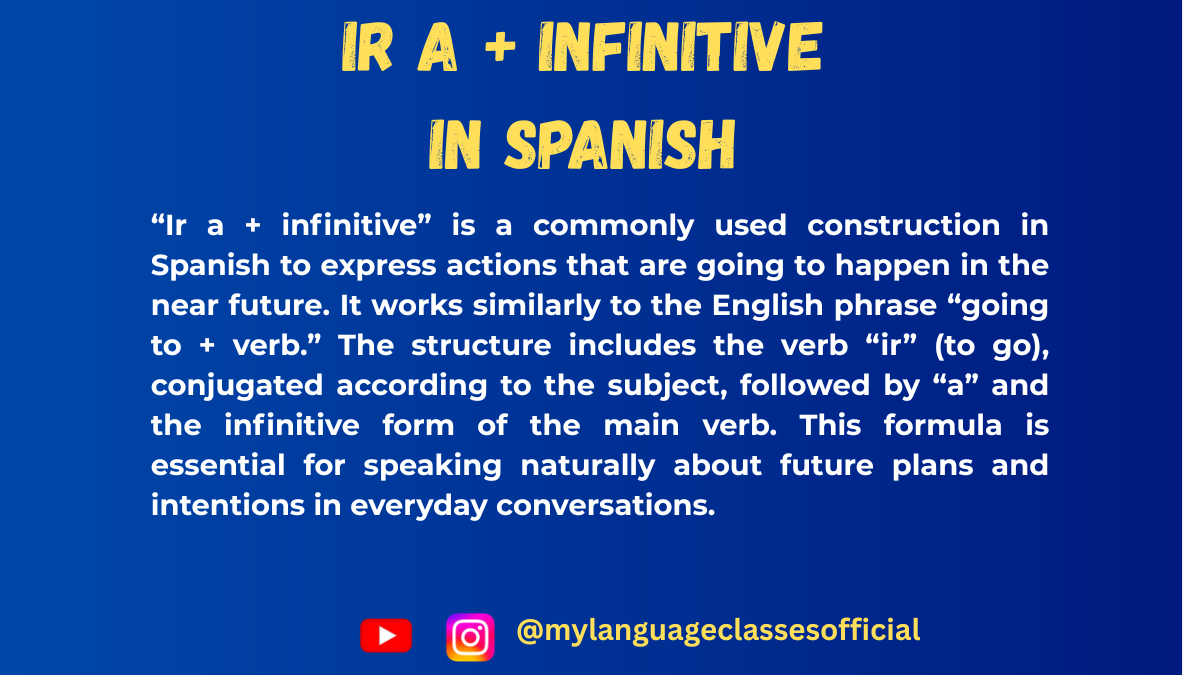
Near Future Tense in Spanish: Mastering Ir a + Infinitive
If you’re learning Spanish, you’ve likely encountered the phrase voy a estudiar (“I’m going to study”). This construction is an example of the near future tense, a simple and versatile way to talk about events that are going to happen soon. Today, we’ll explore how to use this tense, why it’s so practical, and how it compares to other future forms in Spanish. Let’s dive in!
What is the Near Future Tense?
The near future tense in Spanish uses the verb ir (to go), followed by the preposition a and an infinitive verb. It’s similar to the English construction “to be going to + verb.” For example:
- Voy a bailar. – I’m going to dance.
- Vamos a comer. – We’re going to eat.
- Ellos van a viajar. – They’re going to travel.
This structure is widely used in everyday conversation because it’s straightforward and easy to learn.
How to Form the Near Future Tense
The formula is simple:
[Conjugated form of ir] + a + [infinitive verb]Here’s how you conjugate ir in the present tense:
Subject Pronoun Conjugation of ir Yo voy Tú vas Él/Ella/Usted va Nosotros/as vamos Vosotros/as vais Ellos/Ellas/Ustedes van Once you’ve got ir conjugated, just add a and any infinitive verb:
- Voy a leer. – I’m going to read.
- ¿Vas a escribir? – Are you going to write?
- Ellos van a salir. – They are going to go out.
Why Use the Near Future Tense?
The ir a + infinitive construction is perfect for beginners because it’s less complicated than the simple future tense (hablaré, comerás, vivirán). It’s also highly practical—it allows you to talk about immediate plans or intentions without needing to learn additional verb conjugations.
For example:
- Instead of saying Estudiaré mañana (I will study tomorrow), you can say Voy a estudiar mañana (I’m going to study tomorrow).
- Both are correct, but voy a estudiar feels more conversational and is commonly used in informal settings.
Examples of Near Future in Everyday Situations
- Making Plans
- ¿Qué vas a hacer esta tarde? – What are you going to do this afternoon?
- Voy a ir al cine. – I’m going to go to the movies.
- Expressing Intentions
- Vamos a aprender mucho hoy. – We’re going to learn a lot today.
- Voy a ayudar a mi mamá. – I’m going to help my mom.
- Asking Questions
- ¿Vas a venir a la fiesta? – Are you going to come to the party?
- ¿Van a preparar la cena? – Are they going to prepare dinner?
Tips for Mastering the Near Future Tense
- Practice with Everyday Activities: Make a list of what you’re planning to do tomorrow and describe it using ir a + infinitive. For example, Voy a trabajar. Voy a estudiar. Voy a descansar.
- Combine with Time Expressions: Adding time markers helps specify when the action will happen. For example:
- Voy a salir mañana. – I’m going to go out tomorrow.
- Vamos a viajar en verano. – We’re going to travel in summer.
- Roleplay Common Scenarios: Imagine planning a weekend trip, a day at work, or a family gathering. Use phrases like Voy a comprar comida (I’m going to buy food) or Vamos a visitar a nuestros amigos (We’re going to visit our friends).
Comparison with the Simple Future
While the ir a + infinitive construction is easy and practical, the simple future tense (-é, -ás, -á, -emos, -éis, -án) is also important to learn for more formal or distant future events. For example:
- Voy a estudiar español. – I’m going to study Spanish (soon or in the near future).
- Estudiaré español en la universidad. – I will study Spanish at university (a more formal or distant future).
Conclusion
The ir a + infinitive construction is an essential tool for Spanish learners. It’s simple, flexible, and widely used in real-life conversations. By mastering this tense, you’ll be able to express your plans and intentions with confidence.
So, what are you going to do next? (¿Qué vas a hacer ahora?) Practice using this tense, and you’ll see how quickly it becomes a natural part of your Spanish conversations.
¡Buena suerte! 📝
If you enjoyed this lesson, be sure to check out more posts like this on my blog at My Language Classes. Don’t forget to subscribe my YouTube channel and follow me on Instagram for the latest language learning tips and lessons. Leave a comment below to share your thoughts, or ask any questions you have.
Happy learning! 😊
-
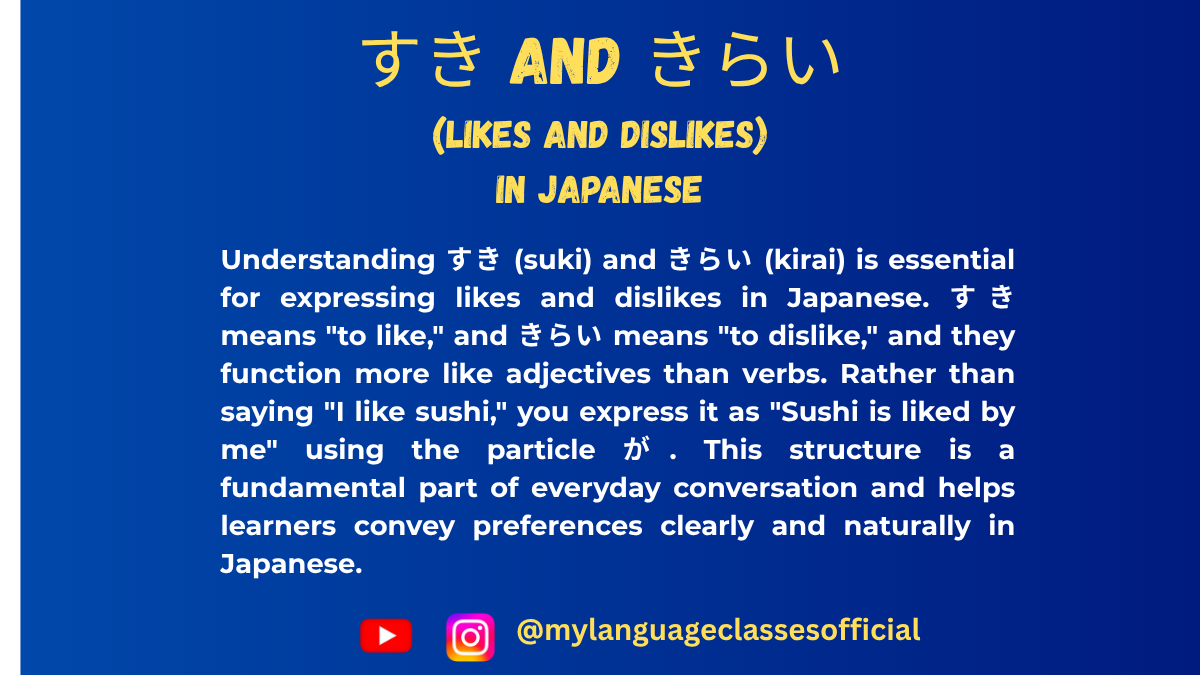
Expressing Likes and Dislikes すき and きらい in Japanese | My Language Classes
Likes and Dislikes in Japanese
こんにちは!(Konnichiwa!)
Learning how to express preferences is one of the most useful and fun parts of mastering Japanese. Today, let’s dive into two essential words: 好き (すき) for “like” and 嫌い (きらい) for “dislike.” Not only will we explore their meanings, but also how to use them naturally in sentences.
1. 好き (すき) – To Like
How to Use 好き
The word 好き means “like” or “fond of” and is commonly used to express your preferences. The structure is simple:
Noun + が好き
This translates to “I like [noun].”Examples:
- 日本語が好きです。
Nihongo ga suki desu.
I like Japanese.- Here, 日本語 (Nihongo) means “Japanese,” and が marks it as the topic you like. Adding です makes it polite.
- 犬が好き。
Inu ga suki.
I like dogs.- This informal version is common among friends or in casual settings.
Expressing Love or Passionate Likes
To emphasize your love or deep passion for something, you can use 大好き (だいすき/daisuki):
- チョコレートが大好きです!
Chokorēto ga daisuki desu!
I love chocolate!
2. 嫌い (きらい) – To Dislike
How to Use 嫌い
On the flip side, 嫌い means “dislike” or “hate.” The structure is the same as 好き:
Noun + が嫌い
This means “I dislike [noun].”Examples:
- ピザが嫌いです。
Piza ga kirai desu.
I dislike pizza.- ピザ (Piza) means “pizza.” While it’s a popular dish, some people might find it too greasy!
- 虫が嫌い。
Mushi ga kirai.
I hate insects.- 虫 (Mushi) refers to “insects.” Use this informal structure with friends.
Expressing Strong Dislike
If you strongly dislike something, you can say 大嫌い (だいきらい/daikirai):
- 雨が大嫌いです!
Ame ga daikirai desu!
I hate rain!
3. Cultural Notes
- “Softer Tone for Dislikes”: In Japanese culture, direct expressions of dislike like 嫌い might come off as too strong in some situations. To soften it, you can use phrases like:
- あまり好きじゃない (Amari suki janai) – “I don’t really like [it].”
- ちょっと苦手です (Chotto nigate desu) – “I’m a bit bad with [it].”
- Overuse of 好き: While 好き is positive, saying it too often might sound insincere. Balance your expressions to match the context.
4. Grammar and Nuance Tips
- No Verb Needed:
Both 好き and 嫌い function as な-adjectives, not verbs. This means they don’t need any conjugation or additional verbs to form basic sentences.Example:- Correct: 猫が好きです。 (Neko ga suki desu. – “I like cats.”)
- Incorrect: 猫が好きをです。 (Neko ga suki wo desu. – This is ungrammatical.)
- が (Ga) vs. は (Wa):
Although が is standard for these structures, は can be used for contrast or emphasis:- 犬は好きですが、猫は嫌いです。
Inu wa suki desu ga, neko wa kirai desu.
I like dogs, but I dislike cats.
- 犬は好きですが、猫は嫌いです。
5. Practice Time!
Let’s put what you’ve learned into action. Try completing these sentences:
- 私は ______ が好きです。
(Watashi wa ______ ga suki desu.)- Translate: “I like ______.”
- 友達は ______ が嫌いです。
(Tomodachi wa ______ ga kirai desu.)- Translate: “My friend dislikes ______.”
- ______ は大好きです!
(______ wa daisuki desu!)- Translate: “I love ______!”
6. Wrap-Up
Now you can confidently express what you like and dislike in Japanese! Start practicing by talking about your favorite foods, hobbies, and activities. Try to notice how native speakers use 好き and 嫌い in conversations—it will deepen your understanding.
If you have questions or want to share your sentences, feel free to leave a comment below!
それでは、またね!(Soredewa, matane!)If you enjoyed this lesson, be sure to check out more posts like this on my blog at My Language Classes. Don’t forget to subscribe my YouTube channel and follow me on Instagram for the latest language learning tips and lessons. Leave a comment below to share your thoughts, or ask any questions you have about nouns.
Happy learning! 😊
- 日本語が好きです。
-
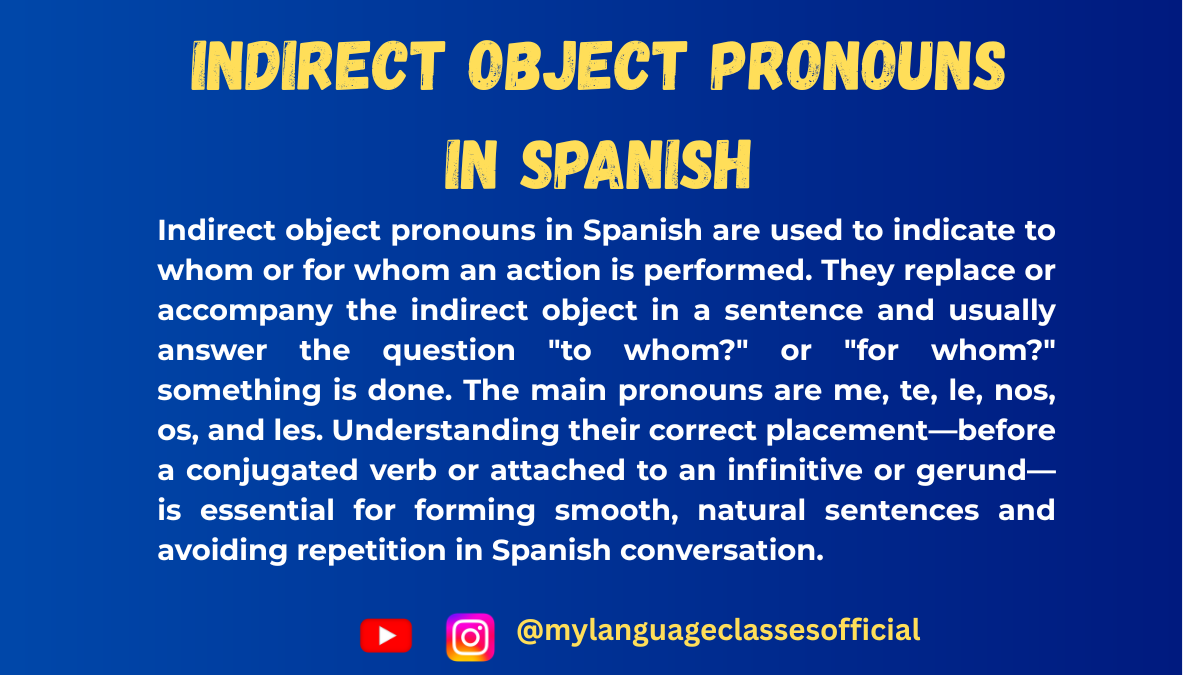
Mastering Indirect Object Pronouns in Spanish
When learning Spanish, understanding indirect object pronouns (pronombres de objeto indirecto) is essential to achieving fluency. These little words pack a big punch, streamlining sentences and helping you sound more natural. In this blog post, we’ll dive into their forms, usage, and provide plenty of examples to solidify your understanding.
What Are Indirect Object Pronouns?
Indirect object pronouns answer the question “To whom?” or “For whom?” an action is performed. They replace the indirect object in a sentence, often saving time and avoiding repetition.
In English:
- He gave her the book.
The pronoun “her” replaces the indirect object (to whom the book was given).
In Spanish:
- Él le dio el libro.
The Indirect Object Pronouns in Spanish
Here are the indirect object pronouns in Spanish:
Pronoun English Equivalent me to/for me te to/for you (informal) le to/for him, her, you (formal) nos to/for us os to/for you (informal plural, used in Spain) les to/for them, you all
Placement of Indirect Object Pronouns
The placement of indirect object pronouns depends on the verb tense and type of verb construction.
1. Before a Conjugated Verb
The indirect object pronoun comes before a conjugated verb.
- María me dio un regalo.
(María gave me a gift.) - ¿Te mandaron la invitación?
(Did they send you the invitation?)
2. Attached to an Infinitive or Gerund
When there’s an infinitive (-ar, -er, -ir) or a gerund (-ando, -iendo), the pronoun can be attached to the verb or placed before the conjugated verb.
- Voy a contarte una historia.
(I’m going to tell you a story.) - Te voy a contar una historia.
(I’m going to tell you a story.) - Estamos escribiéndoles una carta.
(We’re writing them a letter.) - Les estamos escribiendo una carta.
(We’re writing them a letter.)
3. With Commands
- Affirmative commands: Attach the pronoun to the verb.
Dale el libro. (Give him the book.) - Negative commands: Place the pronoun before the verb.
No le des el libro. (Don’t give him the book.)
Indirect Object Pronouns with Clarification
Sometimes, indirect object pronouns like le and les can be ambiguous (they could refer to him, her, it, or them). To clarify, Spanish uses the preposition “a” followed by the indirect object.
- Él le dio un regalo a María.
(He gave a gift to María.)
Even when it’s clear, native speakers often include this redundancy for emphasis:
- A mí me encanta el chocolate.
(I love chocolate.)
The Double Object Pronoun Rule
In Spanish, you can use both a direct object pronoun and an indirect object pronoun in the same sentence. However, when both pronouns begin with “l” (le or les), the indirect object pronoun changes to se.
- Él le dio el libro a María. → Él se lo dio.
(He gave it to her.)
This rule avoids awkward repetition of sounds like “le lo”.
- ¿Les diste la carta? → ¿Se la diste?
(Did you give it to them?)
Practical Tips for Mastery
- Practice Common Verbs: Some verbs are frequently used with indirect object pronouns, such as dar (to give), decir (to say), preguntar (to ask), and gustar (to like).
Example:- ¿Me das tu número de teléfono? (Can you give me your phone number?)
- A ellos les gusta bailar. (They like dancing.)
- Immerse Yourself: Watch movies or read books in Spanish, paying attention to how these pronouns are used.
- Drill Sentence Structures: Write or say sentences with and without the pronouns to see the difference.
Exercises for Practice
- Rewrite the sentences using indirect object pronouns:
a) Yo di flores a mi mamá.
b) Estamos escribiendo una carta a nuestros amigos.
c) Juan va a dar el regalo a ti. - Translate into Spanish:
a) She told him the truth.
b) They bought us a souvenir.
c) I am going to explain the problem to you.
Final Thoughts
Mastering indirect object pronouns is a stepping stone toward fluency in Spanish. With practice and immersion, they’ll soon feel like second nature. Remember to focus on placement, usage rules, and practice as much as possible in real-life scenarios. ¡Buena suerte!
Have questions or want more practice? Drop them in the comments below!
If you enjoyed this lesson, be sure to check out more posts like this on my blog at My Language Classes. Don’t forget to subscribe my YouTube channel and follow me on Instagram for the latest language learning tips and lessons. Leave a comment below to share your thoughts, or ask any questions you have.
Happy learning! 😊
- He gave her the book.
-
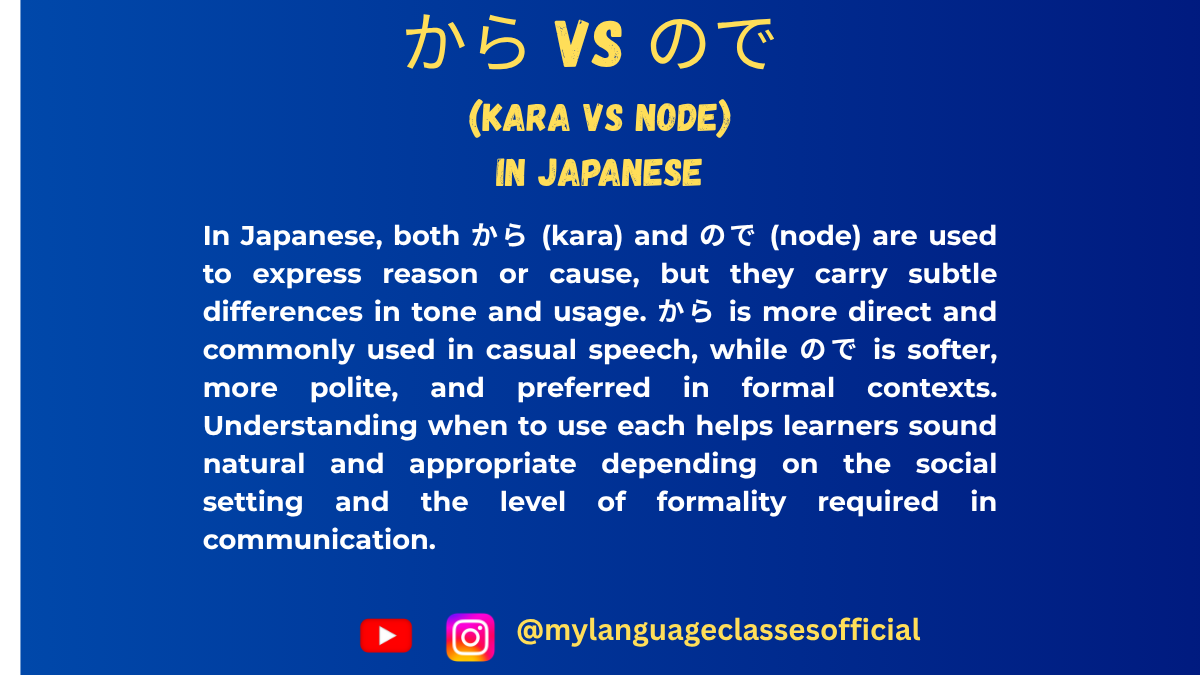
How to Say “Because” in Japanese から (kara) vs. ので (node) | My Language Classes
Expressing “Because” in Japanese: から (kara) vs. ので (node)
When learning Japanese, understanding how to express “because” is essential for forming logical connections in your sentences. Two primary tools for this are から (kara) and ので (node). Both translate roughly to “because” or “since,” but their nuances and appropriate contexts differ. In this post, we’ll explore their meanings, usage, and subtle differences to help you master them.
1. Understanding から (kara)
から is a versatile and commonly used particle to indicate cause and effect. Its usage is straightforward and can be found in both casual and formal contexts, though it often leans more casual.
Structure:
- Reason + から + Result
- Example: 勉強しなかったから、試験に落ちました。
(Benkyou shinakatta kara, shiken ni ochimashita.)
“Because I didn’t study, I failed the exam.”
- Example: 勉強しなかったから、試験に落ちました。
Key Features:
- Direct and Conversational:
から is widely used in everyday speech. It gives a clear and sometimes blunt explanation of reasons.- Example: 雨が降っているから、外に行きません。
(Ame ga futteiru kara, soto ni ikimasen.)
“Because it’s raining, I won’t go outside.”
- Example: 雨が降っているから、外に行きません。
- Flexible Placement:
You can use から in both written and spoken Japanese, though it feels more natural in informal contexts. - Focus on the Speaker’s Perspective:
The reason expressed with から often reflects the speaker’s opinion or justification.
2. Understanding ので (node)
ので is another way to express “because,” but it has a softer, more polite tone. It’s commonly used in formal situations or when you want to sound less direct or imposing.
Structure:
- Reason + ので + Result
- Example: 雨が降っているので、外に行きません。
(Ame ga futteiru node, soto ni ikimasen.)
“Since it’s raining, I won’t go outside.”
- Example: 雨が降っているので、外に行きません。
Key Features:
- Polite and Subtle:
ので carries a sense of consideration, making it ideal for formal or respectful conversations.- Example: お腹が空いたので、何か食べましょう。
(Onaka ga suita node, nanika tabemashou.)
“Since I’m hungry, let’s eat something.”
- Example: お腹が空いたので、何か食べましょう。
- Softer Implications:
Compared to から, ので feels less assertive and more explanatory. It’s often used when the reason is more objective or when you’re asking for understanding. - Common in Formal Writing and Speech:
You’ll frequently see ので in polite correspondence, workplace conversations, and when addressing superiors.
3. Key Differences Between から and ので
Aspect から ので Tone Direct, casual Polite, formal, soft Usage Everyday conversations Formal writing and respectful speech Reason Type Subjective or personal Objective or neutral Politeness Level Casual to neutral Neutral to polite Examples Highlighting the Differences:
- Casual Statement:
- 勉強しなかったから、試験に落ちた。 (Benkyou shinakatta kara, shiken ni ochita.)
“I failed the exam because I didn’t study.” (Direct and casual) - 勉強しなかったので、試験に落ちました。 (Benkyou shinakatta node, shiken ni ochimashita.)
“I failed the exam since I didn’t study.” (Polite and explanatory)
- 勉強しなかったから、試験に落ちた。 (Benkyou shinakatta kara, shiken ni ochita.)
- Polite Request:
- 道が混んでいたから、遅れました。 (Michi ga kondeita kara, okuremashita.)
“I was late because the roads were crowded.” (Blunt explanation) - 道が混んでいたので、遅れました。 (Michi ga kondeita node, okuremashita.)
“I was late since the roads were crowded.” (Polite and considerate)
- 道が混んでいたから、遅れました。 (Michi ga kondeita kara, okuremashita.)
4. When to Use Which?
Use から When:
- Speaking casually with friends or family.
- Explaining personal reasons directly.
- Adding emphasis to the cause-effect relationship.
Use ので When:
- Communicating in formal or polite settings.
- Writing formal letters, essays, or workplace emails.
- Explaining reasons with a softer tone to avoid sounding blunt.
5. A Quick Note on Grammar
- から connects to the plain form of a verb, adjective, or noun:
- Verb: 走るから (Hashiru kara, “Because I run”)
- Adjective: 寒いから (Samui kara, “Because it’s cold”)
- Noun + だ: 先生だから (Sensei da kara, “Because I’m a teacher”)
- ので also connects to the plain form, but nouns and な-adjectives require な before ので:
- Verb: 走るので (Hashiru node, “Since I run”)
- Adjective: 寒いので (Samui node, “Since it’s cold”)
- Noun + な: 先生なので (Sensei na node, “Since I’m a teacher”)
6. Practice Makes Perfect!
Understanding から and ので is only the beginning. Try using them in sentences to express reasons for daily activities. For example:
- 電車が遅れたから、会議に間に合いませんでした。
(Densha ga okureta kara, kaigi ni ma ni aimasendeshita.)
“Because the train was delayed, I couldn’t make it to the meeting.” - 電車が遅れたので、会議に間に合いませんでした。
(Densha ga okureta node, kaigi ni ma ni aimasendeshita.)
“Since the train was delayed, I couldn’t make it to the meeting.”
By practicing these expressions in context, you’ll develop an intuitive sense of when to use から and ので, enhancing both your fluency and sensitivity to Japanese communication styles. Keep practicing, and don’t hesitate to mix them into your conversations!
If you enjoyed this lesson, be sure to check out more posts like this on my blog at My Language Classes. Don’t forget to subscribe my YouTube channel and follow me on Instagram for the latest language learning tips and lessons. Leave a comment below to share your thoughts, or ask any questions you have about nouns.
Happy learning! 😊
- Reason + から + Result
-
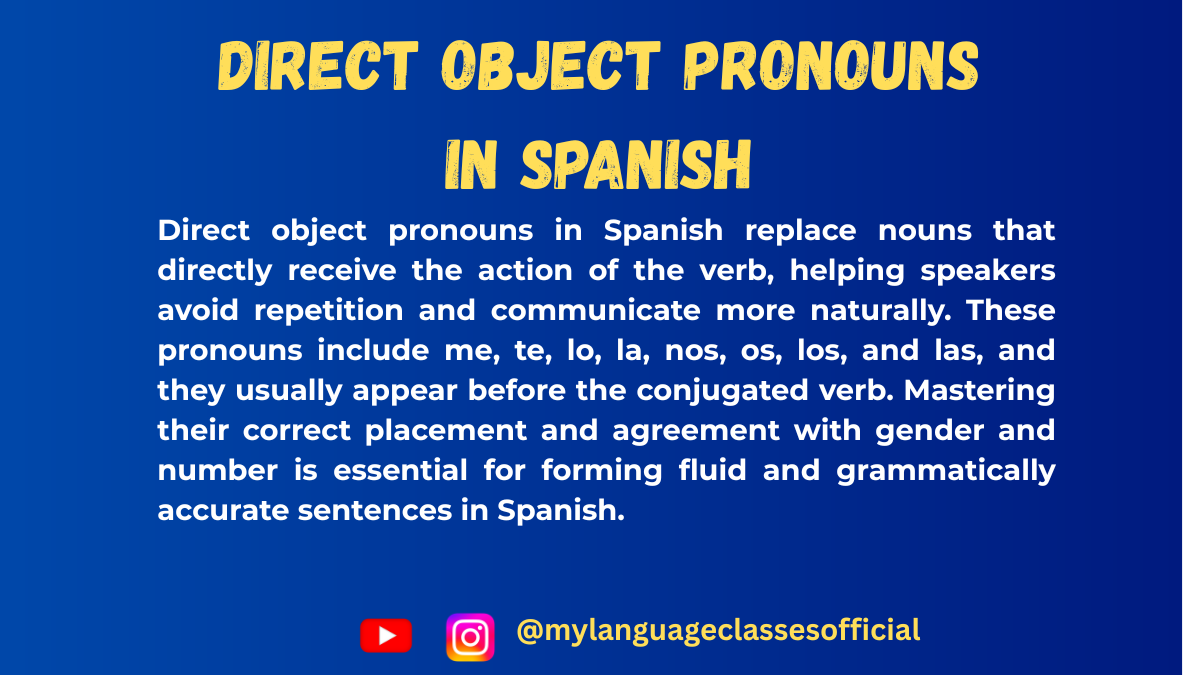
Mastering Direct Object Pronouns in Spanish
When learning Spanish, one of the most essential skills is understanding how to use direct object pronouns. These little words can simplify your sentences and make your speech sound more fluid and natural. In this blog, we’ll explore what direct object pronouns are, how they’re used, and provide plenty of examples to help you master them.
What Are Direct Object Pronouns?
A direct object in a sentence answers the questions “what?” or “whom?” about the verb. For example:
- I see the book. (What do I see? The book.)
- She calls her friend. (Whom does she call? Her friend.)
In Spanish, instead of repeating the noun (like “the book” or “her friend”), we replace it with a direct object pronoun.
The Direct Object Pronouns in Spanish
Here’s a handy table of direct object pronouns:
Pronoun English Meaning Me Me Te You (informal) Lo Him/It (masculine) La Her/It (feminine) Nos Us Os You all (informal, Spain) Los Them (masculine/mixed) Las Them (feminine)
Placement of Direct Object Pronouns
In Spanish, the placement of direct object pronouns can seem tricky at first, but there are clear rules:
- Before a Conjugated Verb
- Example:
- Yo veo el carro. (I see the car.) → Yo lo veo. (I see it.)
- Ella compra las flores. (She buys the flowers.) → Ella las compra. (She buys them.)
- Example:
- Attached to an Infinitive
- Example:
- Voy a llamar a María. (I am going to call María.) → Voy a llamarla. (I am going to call her.)
- Example:
- Attached to a Present Participle
- Example:
- Estoy leyendo el libro. (I am reading the book.) → Estoy leyéndolo. (I am reading it.)
- Note: Add an accent to maintain proper stress when attaching the pronoun.
- Example:
- Attached to an Affirmative Command
- Example:
- Compra el pan. (Buy the bread.) → Cómpralo. (Buy it.)
- Note: Add an accent when necessary to preserve the original stress.
- Example:
Examples in Action
Here are some real-life scenarios where direct object pronouns are used:
Simple Sentences
- ¿Tienes el dinero? (Do you have the money?)
→ Sí, lo tengo. (Yes, I have it.) - ¿Conoces a Ana? (Do you know Ana?)
→ Sí, la conozco. (Yes, I know her.)
Questions and Negatives
- ¿Estás mirando la televisión? (Are you watching the TV?)
→ No, no la estoy mirando. (No, I’m not watching it.)
Infinitives
- ¿Vas a ver la película? (Are you going to watch the movie?)
→ Sí, voy a verla. (Yes, I’m going to watch it.)
Commands
- Escribe la carta. (Write the letter.)
→ Escríbela. (Write it.)
Common Errors to Avoid
- Confusing Direct and Indirect Object Pronouns
Remember, direct object pronouns answer “what?” or “whom?”, while indirect object pronouns answer “to whom?” or “for whom?”Example:- Direct: Lo veo. (I see him.)
- Indirect: Le hablo. (I speak to him.)
- Forgetting to Match Gender and Number
Make sure the pronoun matches the noun in gender and number. For example:- Las cartas (the letters) → las
- El carro (the car) → lo
- Misplacing Pronouns
Incorrect: Voy llamarla.
Correct: Voy a llamarla or La voy a llamar.
Practice Time!
Let’s put your skills to the test. Try replacing the direct object with a pronoun in the following sentences:
- Yo compro las manzanas.
- Nosotros vemos a Juan.
- María está leyendo el libro.
- ¿Has visto a tus amigos?
- Compra los billetes.
Answers
- Yo las compro.
- Nosotros lo vemos.
- María está leyéndolo.
- ¿Los has visto?
- Cómpralos.
Final Thoughts
Direct object pronouns are a powerful tool to make your Spanish more efficient and natural. With practice, using them will become second nature. Start incorporating them into your conversations today—you’ve got this!
Keep practicing, and soon you’ll sound like a native! 😊
If you enjoyed this lesson, be sure to check out more posts like this on my blog at My Language Classes. Don’t forget to subscribe my YouTube channel and follow me on Instagram for the latest language learning tips and lessons. Leave a comment below to share your thoughts, or ask any questions you have.
Happy learning! 😊
-

Reflexive Verbs in Spanish
¡Hola, amigos! Welcome back to My Spanish Class, your go-to blog for learning Spanish the fun and effective way. In today’s post, we’re diving into one of the most essential and fascinating aspects of Spanish grammar: reflexive verbs. Whether you’re a beginner or brushing up on your skills, this guide has you covered.
What Are Reflexive Verbs?
In Spanish, a reflexive verb indicates that the subject of the sentence is also the receiver of the action. In simpler terms, the action reflects back on the subject. Reflexive verbs are commonly used for daily routines, emotions, and actions related to oneself.
For example:
- Me baño (I bathe myself).
- Se despierta (He/She wakes up).
The key to identifying reflexive verbs is the reflexive pronoun (me, te, se, nos, os, se) and the verb ending in -se in its infinitive form, like bañarse (to bathe oneself).
How to Form Reflexive Verbs
Reflexive verbs are formed by combining the reflexive pronoun with the correct conjugation of the verb. Here’s a step-by-step guide:
- Start with the infinitive: For example, levantarse (to get up).
- Remove the -se: You’re left with the verb root, levantar.
- Conjugate the verb: Conjugate the verb as you normally would for the subject.
- Add the reflexive pronoun: Place the appropriate reflexive pronoun (me, te, se, nos, os, se) before the conjugated verb.
Here’s the breakdown for levantarse in the present tense:
Subject Reflexive Pronoun Verb Form Result Yo me levanto Me levanto Tú te levantas Te levantas Él/Ella/Usted se levanta Se levanta Nosotros nos levantamos Nos levantamos Vosotros os levantáis Os levantáis Ellos/Ellas/Ustedes se levantan Se levantan
Reflexive Pronouns
Here’s a quick table of reflexive pronouns in Spanish:
Subject Reflexive Pronoun Yo me Tú te Él/Ella/Usted se Nosotros nos Vosotros os Ellos/Ellas/Ustedes se
Commonly Used Reflexive Verbs
Here’s a list of reflexive verbs that you’ll encounter frequently:
- Daily Routines
- Despertarse (to wake up)
- Levantarse (to get up)
- Vestirse (to get dressed)
- Lavarse (to wash oneself)
- Cepillarse (to brush, e.g., teeth or hair)
- Peinarse (to comb one’s hair)
- Maquillarse (to put on makeup)
- Bañarse (to bathe oneself)
- Ducharse (to shower oneself)
- Emotions and States
- Enojarse (to get angry)
- Alegrarse (to get happy)
- Preocuparse (to worry)
- Sentirse (to feel)
- Calmarse (to calm down)
- Social and Interpersonal Actions
- Casarse (to get married)
- Divertirse (to have fun)
- Despedirse (to say goodbye)
- Quedarse (to stay)
- Aburrirse (to get bored)
Conjugation Table Example: Despertarse
Let’s take the verb despertarse (to wake up) as an example and conjugate it in the present tense:
Subject Reflexive Pronoun Verb Conjugation Result Yo me despierto Me despierto Tú te despiertas Te despiertas Él/Ella/Usted se despierta Se despierta Nosotros nos despertamos Nos despertamos Vosotros os despertáis Os despertáis Ellos/Ellas/Ustedes se despiertan Se despiertan Here are some example sentences using reflexive verbs in Spanish, along with their English translations. These examples cover different contexts such as daily routines, emotions, and social actions:
Daily Routines
- Me despierto a las seis de la mañana.
(I wake up at six in the morning.) - Después de despertarme, me levanto inmediatamente.
(After waking up, I get up immediately.) - Se cepilla los dientes tres veces al día.
(He/She brushes their teeth three times a day.) - Nos duchamos después de hacer ejercicio.
(We shower after exercising.) - ¿Te peinas el cabello todos los días?
(Do you comb your hair every day?)
Emotions and States
- Me siento muy feliz hoy.
(I feel very happy today.) - ¿Te preocupas mucho por los exámenes?
(Do you worry a lot about exams?) - Se enoja cuando alguien llega tarde.
(He/She gets angry when someone arrives late.) - Nos calmamos después de hablar con el profesor.
(We calmed down after talking to the teacher.) - Ellos se aburren en las clases largas.
(They get bored in long classes.)
Social and Interpersonal Actions
- Me caso con mi pareja el próximo mes.
(I’m getting married to my partner next month.) - Nos despedimos de nuestros amigos en la estación de tren.
(We said goodbye to our friends at the train station.) - Se divierten mucho en las fiestas.
(They have a lot of fun at parties.) - Te quedas en casa cuando llueve mucho, ¿verdad?
(You stay home when it rains a lot, right?) - Me arrepiento de no haber estudiado más para el examen.
(I regret not having studied more for the exam.)
Reflexive vs. Non-Reflexive Verbs
Some verbs can be used reflexively or non-reflexively depending on the meaning. Here are examples to show the difference:
Reflexive: Me lavo las manos antes de comer.
(I wash my hands before eating.)Non-Reflexive: Lavo los platos después de la cena.
(I wash the dishes after dinner.)Reflexive: Se despierta temprano los fines de semana.
(He/She wakes up early on weekends.)Non-Reflexive: El ruido despierta al bebé.
(The noise wakes up the baby.)
Practice these sentences by writing and speaking them aloud to get comfortable with reflexive verbs in various contexts.
Tips for Learning Reflexive Verbs
- Practice Daily Routines: Write out your morning or evening routine using reflexive verbs.
- Watch Spanish Videos: Look for content on YouTube (like my channel 😉) that uses reflexive verbs in context.
- Memorize Reflexive Pronouns: These are your best friends when working with reflexive verbs.
- Conjugation Drills: Create a table of conjugations and practice until they’re second nature.
Final Thoughts
Learning reflexive verbs might seem tricky at first, but with practice, they’ll become a natural part of your Spanish vocabulary. Remember, reflexive verbs add richness to your conversations, letting you describe actions that involve yourself or your feelings.
If you enjoyed this lesson, be sure to check out more posts like this on my blog at My Language Classes. Don’t forget to subscribe my YouTube channel and follow me on Instagram for the latest language learning tips and lessons. Leave a comment below to share your thoughts, or ask any questions you have.
Happy learning! 😊
-
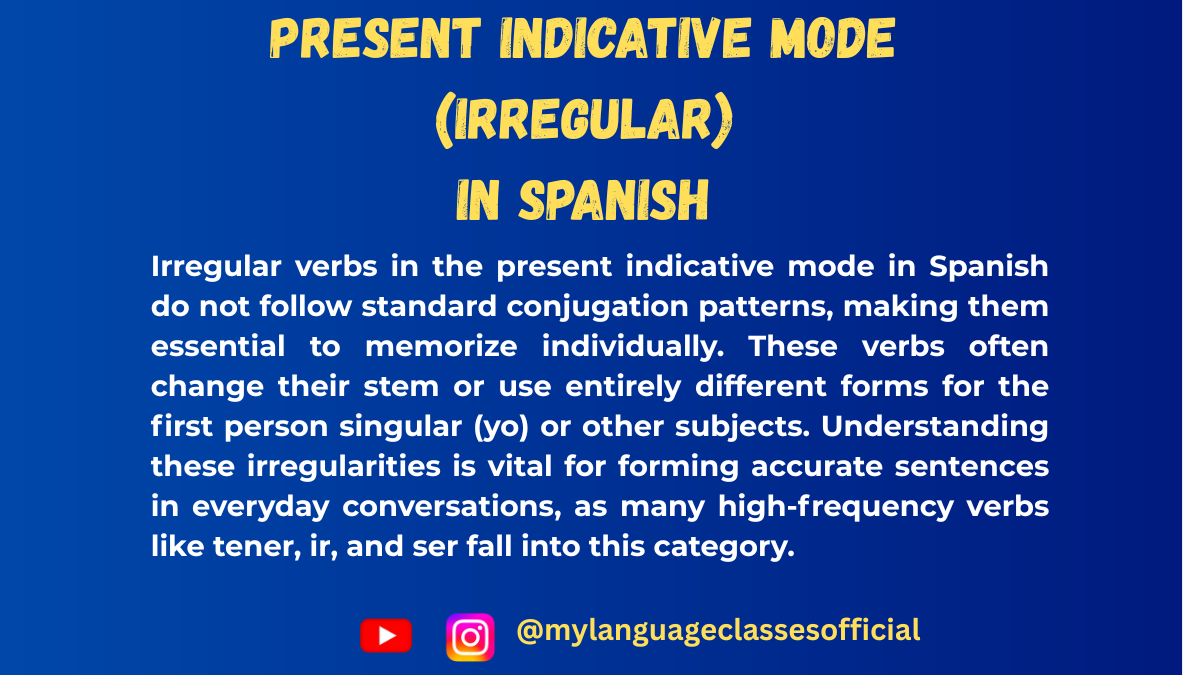
Mastering Irregular Verbs in the Present Indicative mode in Spanish
Learning Spanish can be an exciting adventure, but the irregular verbs in the present indicative mode can often make it feel like a tricky puzzle. Don’t worry! In this blog post, we’ll break down the categories of irregular verbs and provide clear examples to help you navigate through them. Whether you’re a beginner or looking to solidify your skills, this guide is for you.
What is the Present Indicative Mode?
The present indicative mode is used to describe actions happening right now, habitual actions, or general truths. While most verbs follow a regular conjugation pattern, some verbs have irregularities. These irregular verbs fall into distinct categories that can be easily learned with practice.
1. Stem-Changing Verbs (Boot Verbs)
Stem-changing verbs undergo a vowel change in the stem in all forms except nosotros and vosotros. The three main changes are:
- e → ie
- o → ue
- e → i
e → ie Verbs
These verbs replace the vowel e with ie in all forms except nosotros and vosotros.
Infinitive Yo Tú Él/Ella/Usted Nosotros Vosotros Ellos/Ellas/Ustedes Pensar Pienso Piensas Piensa Pensamos Pensáis Piensan Querer Quiero Quieres Quiere Queremos Queréis Quieren Other e → ie Verbs:
Preferir, cerrar, comenzar, entender.
o → ue Verbs
These verbs replace the vowel o with ue in all forms except nosotros and vosotros.
Infinitive Yo Tú Él/Ella/Usted Nosotros Vosotros Ellos/Ellas/Ustedes Dormir Duermo Duermes Duerme Dormimos Dormís Duermen Volver Vuelvo Vuelves Vuelve Volvemos Volvéis Vuelven Other o → ue Verbs:
Morir, almorzar, costar, encontrar.
e → i Verbs
These verbs replace the vowel e with i in all forms except nosotros and vosotros.
Infinitive Yo Tú Él/Ella/Usted Nosotros Vosotros Ellos/Ellas/Ustedes Pedir Pido Pides Pide Pedimos Pedís Piden Servir Sirvo Sirves Sirve Servimos Servís Sirven Other e → i Verbs:
Repetir, elegir, vestir.
2. Yo Irregulars
In these verbs, the irregularity occurs only in the yo form, with specific spelling changes:
- Verbs ending in -cer or -cir change to -zco in the yo form.
- Verbs ending in -ger or -gir change to -jo in the yo form.
-cer / -cir → -zco
Infinitive Yo Tú Él/Ella/Usted Nosotros Vosotros Ellos/Ellas/Ustedes Conocer Conozco Conoces Conoce Conocemos Conocéis Conocen Traducir Traduzco Traduces Traduce Traducimos Traducís Traducen Other -cer/-cir Verbs:
Ofrecer, producir, parecer.-ger / -gir → -jo
Infinitive Yo Tú Él/Ella/Usted Nosotros Vosotros Ellos/Ellas/Ustedes Escoger Escojo Escoges Escoge Escogemos Escogéis Escogen Dirigir Dirijo Diriges Dirige Dirigimos Dirigís Dirigen Other -ger/-gir Verbs:
Exigir, proteger.
3. Totally Irregular Verbs
These verbs do not follow any predictable patterns and must be memorized individually.
Ser (to be)
Yo Tú Él/Ella/Usted Nosotros Vosotros Ellos/Ellas/Ustedes Soy Eres Es Somos Sois Son Ir (to go)
Yo Tú Él/Ella/Usted Nosotros Vosotros Ellos/Ellas/Ustedes Voy Vas Va Vamos Vais Van Other Totally Irregular Verbs:
Haber, estar.
4. Spelling Changes for Phonetic Reasons
Verbs ending in -uir (except -guir) add a y in all forms except nosotros and vosotros.
Infinitive Yo Tú Él/Ella/Usted Nosotros Vosotros Ellos/Ellas/Ustedes Construir Construyo Construyes Construye Construimos Construís Construyen Other Verbs with Spelling Changes:
Incluir, destruir, huir.
Wrapping Up
By categorizing irregular verbs and practicing with these tables, you can systematically conquer their complexities. The key is consistency and practice. Bookmark this guide and refer back to it as you progress on your Spanish journey.
¿Cuáles son tus verbos irregulares favoritos? Share your thoughts in the comments below!
If you enjoyed this lesson, be sure to check out more posts like this on my blog at My Language Classes. Don’t forget to subscribe my YouTube channel and follow me on Instagram for the latest language learning tips and lessons. Leave a comment below to share your thoughts, or ask any questions you have.
Happy learning! 😊
-

Mastering the Present Indicative Mode in Spanish (Regular verbs)
¡Hola, amigos! If you’re learning Spanish, mastering verb conjugations is essential. Today, we’ll dive deep into one of the most foundational concepts: the present indicative mode of regular verbs. This is crucial because it allows you to talk about habitual actions, general truths, and things happening right now.
In this blog, I’ll guide you through the patterns for regular verbs ending in -AR, -ER, and -IR, so you can conjugate like a pro! Let’s break it down step by step.
1. What Is the Present Indicative Mode?
The present indicative mode is used to describe:
- Actions happening in the present.
- Yo estudio español. (I study Spanish.)
- Habits or routines.
- Nosotros comemos a las ocho. (We eat at 8.)
- Universal truths.
- El sol brilla. (The sun shines.)
It’s also the base for learning other tenses, so nailing this is critical for fluency.
2. The Big Three: -AR, -ER, and -IR Verbs
Spanish verbs fall into three categories based on their endings: -AR, -ER, and -IR. These endings determine how the verb conjugates.
Let’s take an example of each:
- -AR: hablar (to talk)
- -ER: comer (to eat)
- -IR: vivir (to live)
3. The Formula for Conjugation
To conjugate a regular verb in the present indicative:
- Remove the infinitive ending (-ar, -er, -ir).
- Add the appropriate ending based on the subject (yo, tú, él, etc.).
Here are the endings:
-AR Verbs
Subject Ending Example (hablar) Yo -o hablo Tú -as hablas Él/Ella/Usted -a habla Nosotros -amos hablamos Vosotros -áis habláis Ellos/Ellas/Ustedes -an hablan -ER Verbs
Subject Ending Example (comer) Yo -o como Tú -es comes Él/Ella/Usted -e come Nosotros -emos comemos Vosotros -éis coméis Ellos/Ellas/Ustedes -en comen -IR Verbs
Subject Ending Example (vivir) Yo -o vivo Tú -es vives Él/Ella/Usted -e vive Nosotros -imos vivimos Vosotros -ís vivís Ellos/Ellas/Ustedes -en viven
4. Quick Tips for Practice
- Memorize the Patterns
Use flashcards or apps to drill conjugations. Focus on one category at a time. - Practice with Common Verbs
Start with frequently used verbs like:- hablar (to talk), trabajar (to work), estudiar (to study)
- comer (to eat), beber (to drink), leer (to read)
- vivir (to live), escribir (to write), abrir (to open)
- Create Sentences
Write sentences about your daily life:- Yo como pizza los viernes. (I eat pizza on Fridays.)
- Nosotros vivimos en Nueva York. (We live in New York.)
- Speak Out Loud
Practice saying conjugations and sentences out loud to build muscle memory.
5. Common Mistakes to Avoid
- Mixing up -ER and -IR endings
For nosotros and vosotros, -ER verbs use -emos/-éis, while -IR verbs use -imos/-ís. - Forgetting Subject Pronouns
Spanish often omits subject pronouns because the verb form makes the subject clear. For example:- Hablo español. (I speak Spanish.)
You don’t need to say “Yo hablo español” unless you want to emphasize “I.”
- Hablo español. (I speak Spanish.)
6. Bonus: Practice Exercise!
Conjugate the following verbs in the present indicative:
- Trabajar (yo, tú, él)
- Leer (nosotros, ellos)
- Escribir (vosotros, usted)
Answers:
- Trabajo, trabajas, trabaja
- Leemos, leen
- Escribís, escribe
Ready to Practice? ¡A Conjugar!
The present indicative is your gateway to confidently expressing yourself in Spanish. Keep practicing, and soon you’ll find it as easy as uno, dos, tres.
If you enjoyed this lesson, be sure to check out more posts like this on my blog at My Language Classes. Don’t forget to subscribe my YouTube channel and follow me on Instagram for the latest language learning tips and lessons. Leave a comment below to share your thoughts, or ask any questions you have.
Happy learning! 😊
- Actions happening in the present.
-
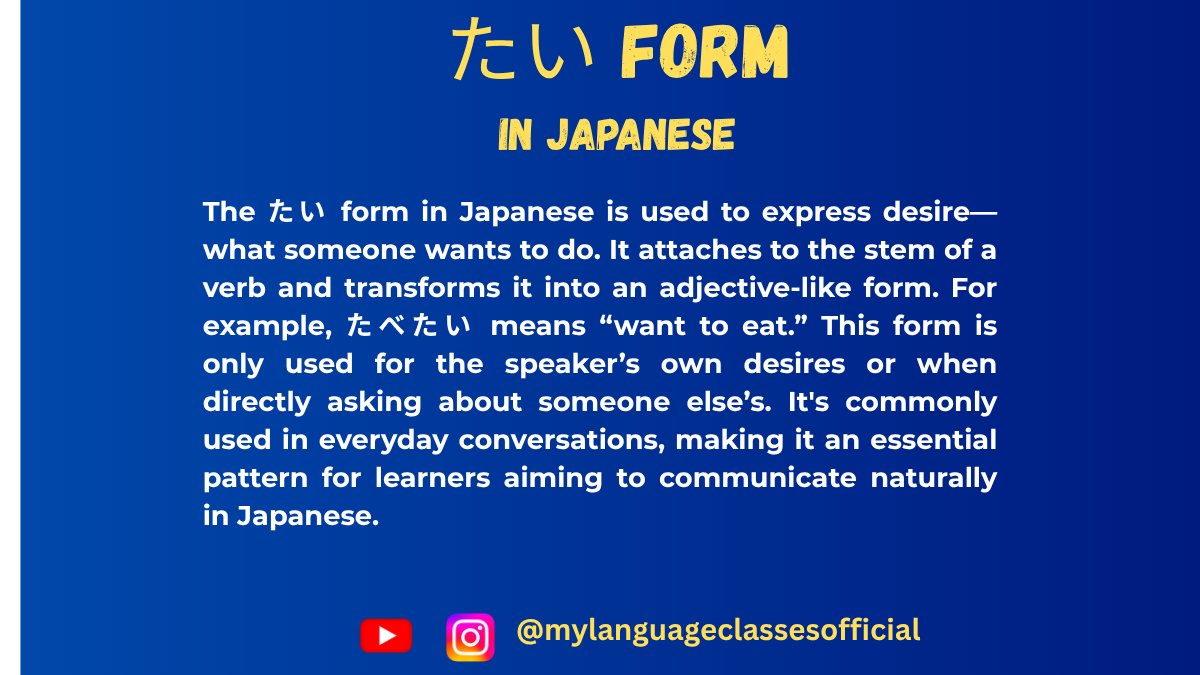
How to Use たい Form in Japanese | My Language Classes
Mastering the Japanese たい Form: A Comprehensive Guide
When learning Japanese, expressing what you want to do is an exciting milestone. The たい form is a versatile and commonly used grammar pattern that helps convey your desires and preferences. Whether you’re talking about your favorite foods, activities, or hobbies, mastering the たい form will greatly enhance your conversational skills. Let’s break it down step by step!
What Is the たい Form?
The たい form is used to express the desire to perform a certain action. In English, this is equivalent to saying, “I want to [do something].” It attaches to the stem of a verb, making it both straightforward and easy to use.
Building the たい Form for All Verb Groups
In Japanese, verbs are categorized into three groups: Group 1 (う-verbs), Group 2 (る-verbs), and Group 3 (Irregular verbs). Let’s dive into how to form the たい form for each group.
Group 1 (う-Verbs)
Group 1 verbs, also known as う-verbs, have dictionary forms that end with an う sound (e.g., 飲む, 読む, 書く).
Steps to form the たい form:
- Remove the final う sound from the verb.
- Replace it with い and add たい.
Examples:
- 飲む (nomu, “to drink”) → 飲みたい (nomitai, “want to drink”)
- 読む (yomu, “to read”) → 読みたい (yomitai, “want to read”)
- 書く (kaku, “to write”) → 書きたい (kakitai, “want to write”)
Negative form:
- Follow the same steps to form the たい structure.
- Replace たい with たくない.
Examples:
- 飲む → 飲みたくない (nomitakunai, “don’t want to drink”)
- 読む → 読みたくない (yomitakunai, “don’t want to read”)
- 書く → 書きたくない (kakitakunai, “don’t want to write”)
Group 2 (る-Verbs)
Group 2 verbs, also known as る-verbs, have dictionary forms that end with る preceded by an い or え sound (e.g., 食べる, 見る).
Steps to form the たい form:
- Drop the る from the verb.
- Add たい to the stem.
Examples:
- 食べる (taberu, “to eat”) → 食べたい (tabetai, “want to eat”)
- 見る (miru, “to see/watch”) → 見たい (mitai, “want to see/watch”)
- 開ける (akeru, “to open”) → 開けたい (aketai, “want to open”)
Negative form:
- Drop the る from the verb.
- Add たくない to the stem.
Examples:
- 食べる → 食べたくない (tabetakunai, “don’t want to eat”)
- 見る → 見たくない (mitakunai, “don’t want to see/watch”)
- 開ける → 開けたくない (aketakunai, “don’t want to open”)
Group 3 (Irregular Verbs)
Group 3, or irregular verbs, includes only two main verbs: する (“to do”) and 来る (“to come”).
Steps to form the たい form:
- する: Replace する with したい.
- 来る: Change to 来たい (きたい, kitai).
Examples:
- する (suru, “to do”) → したい (shitai, “want to do”)
- 来る (kuru, “to come”) → 来たい (kitai, “want to come”)
Negative form:
- する: Replace したい with したくない.
- 来る: Replace 来たい with 来たくない.
Examples:
- する → したくない (shitakunai, “don’t want to do”)
- 来る → 来たくない (kitakunai, “don’t want to come”)
Summary Chart
Verb Type Dictionary Form Stem Positive たい Form Negative たくない Form Group 1 (う) 飲む (nomu) 飲み 飲みたい (nomitai) 飲みたくない (nomitakunai) Group 2 (る) 食べる (taberu) 食べ 食べたい (tabetai) 食べたくない (tabetakunai) Group 3 (Irregular) する (suru) — したい (shitai) したくない (shitakunai) 来る (kuru) — 来たい (kitai) 来たくない (kitakunai) Practice It!
Try converting the following verbs into their たい and たくない forms:
- 書く (kaku, “to write”)
- 遊ぶ (asobu, “to play”)
- 勉強する (benkyou suru, “to study”)
- 起きる (okiru, “to wake up”)
Let us know how you did in the comments!
Polite Forms
The examples above are in casual form, which is great for conversations with friends or family. To make it polite, simply conjugate the たい form with です:
- 食べたい → 食べたいです (tabetai desu, “want to eat”).
- 食べたくない → 食べたくないです (tabetakunai desu, “don’t want to eat”).
Examples:
- 映画を見たいです。
Eiga o mitai desu.
“I want to watch a movie.” - 海に行きたくないです。
Umi ni ikitakunai desu.
“I don’t want to go to the beach.”
Notes on Usage
- First-Person Focus:
The たい form is primarily used to express the speaker’s desires. For example:- 私はケーキを食べたいです。
Watashi wa keeki o tabetai desu.
“I want to eat cake.”
- 私はケーキを食べたいです。
- Context Matters:
Use たい sparingly in formal writing or professional settings. Instead, opt for more polite expressions such as ~たいと思っています (~tai to omotteimasu, “I am thinking I want to…”). - Flexibility in Sentences:
The たい form is flexible and integrates seamlessly into various sentence structures:- 何を食べたいですか?
Nani o tabetai desu ka?
“What do you want to eat?” - 明日は公園に行きたいです。
Ashita wa kouen ni ikitai desu.
“I want to go to the park tomorrow.”
- 何を食べたいですか?
Practice Makes Perfect
Try creating your own sentences with the たい form! Here are some practice prompts:
- What do you want to do this weekend?
- Name three things you don’t want to do.
- Use the たい form in a polite question.
Final Thoughts
The たい form is a valuable tool for expressing your wants and preferences in Japanese. Whether you’re planning your next meal or your next adventure, it helps bring personality and clarity to your conversations. Practice it often, and you’ll find yourself communicating your desires naturally in no time. 頑張って!(Ganbatte! – Good luck!)
What do you want to express in Japanese today? Share in the comments below! 😊
If you enjoyed this lesson, be sure to check out more posts like this on my blog at My Language Classes. Don’t forget to subscribe my YouTube channel and follow me on Instagram for the latest language learning tips and lessons. Leave a comment below to share your thoughts, or ask any questions you have about nouns.
Happy learning! 😊

